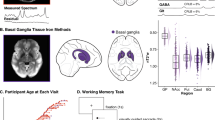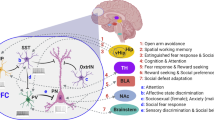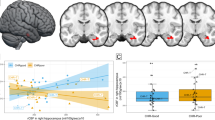Abstract
Dopamine modulation of GABAergic transmission in the prefrontal cortex (PFC) is thought to be critical for sustaining cognitive processes such as working memory and decision-making. Here, we developed a neurocomputational model of the PFC that includes physiological features of the facilitatory action of dopamine on fast-spiking interneurons to assess how a GABAergic dysregulation impacts on the prefrontal network stability and working memory. We found that a particular non-linear relationship between dopamine transmission and GABA function is required to enable input selectivity in the PFC for the formation and retention of working memory. Either degradation of the dopamine signal or the GABAergic function is sufficient to elicit hyperexcitability in pyramidal neurons and working memory impairments. The simulations also revealed an inverted U-shape relationship between working memory and dopamine, a function that is maintained even at high levels of GABA degradation. In fact, the working memory deficits resulting from reduced GABAergic transmission can be rescued by increasing dopamine tone and vice versa. We also examined the role of this dopamine–GABA interaction for the termination of working memory and found that the extent of GABAergic excitation needed to reset the PFC network begins to occur when the activity of fast-spiking interneurons surpasses 40 Hz. Together, these results indicate that the capability of the PFC to sustain working memory and network stability depends on a robust interplay of compensatory mechanisms between dopamine tone and the activity of local GABAergic interneurons.
Similar content being viewed by others
Log in or create a free account to read this content
Gain free access to this article, as well as selected content from this journal and more on nature.com
or
References
Abela AR, Dougherty SD, Fagen ED, Hill CJ, Chudasama Y (2012). Inhibitory control deficits in rats with ventral hippocampal lesions. Cereb Cortex 23: 1396–1409.
Baldwin AE, Sadeghian K, Kelley AE (2002). Appetitive instrumental learning requires coincident activation of NMDA and dopamine D1 receptors within the medial prefrontal cortex. J Neurosci 22: 1063–1071.
Bartos M, Elgueta C (2012). Functional characteristics of parvalbumin- and cholecystokinin-expressing basket cells. J Physiol 590 (Pt 4): 669–681.
Best JR, Miller PH (2010). A developmental perspective on executive function. Child Dev 81: 1641–1660.
Brady AM (2009). Neonatal ventral hippocampal lesions disrupt set-shifting ability in adult rats. Behav Brain Res 205: 294–298.
Brunel N, Wang XJ (2001). Effects of neuromodulation in a cortical network model of object working memory dominated by recurrent inhibition. J Comput Neurosci 11: 63–85.
Casey BJ, Giedd JN, Thomas KM (2000). Structural and functional brain development and its relation to cognitive development. Biol Psychol 54: 241–257.
Casey BJ, Jones RM, Hare TA (2008). The adolescent brain. Ann NY Acad Sci 1124: 111–126.
Chudasama Y, Doobay VM, Liu Y (2012). Hippocampal-prefrontal cortical circuit mediates inhibitory response control in the rat. J Neurosci 32: 10915–10924.
Davis M, Whalen PJ (2001). The amygdala: vigilance and emotion. Mol Psychiatry 6: 13–34.
Durstewitz D, Seamans JK, Sejnowski TJ (2000). Dopamine-mediated stabilization of delay-period activity in a network model of prefrontal cortex. J Neurophysiol 83: 1733–1750.
Enomoto T, Tse MT, Floresco SB (2011). Reducing prefrontal gamma-aminobutyric acid activity induces cognitive, behavioral, and dopaminergic abnormalities that resemble schizophrenia. Biol Psychiatry 69: 432–441.
Ferron A, Thierry AM, Le Douarin C, Glowinski J (1984). Inhibitory influence of the mesocortical dopaminergic system on spontaneous activity or excitatory response induced from the thalamic mediodorsal nucleus in the rat medial prefrontal cortex. Brain Res 302: 257–265.
Flores-Barrera E, Thomases DR, Heng LJ, Cass DK, Caballero A, Tseng KY (2013). Late adolescent expression of GluN2B transmission in the prefrontal cortex is input-specific and requires postsynaptic PKA and D1 dopamine receptor signaling. Biol Psychiatry 75: 508–516.
Floresco SB (2013). Prefrontal dopamine and behavioral flexibility: shifting from an "inverted-U" toward a family of functions. Front Neurosci 7: 62.
Floresco SB, Phillips AG (2001). Delay-dependent modulation of memory retrieval by infusion of a dopamine D1 agonist into the rat medial prefrontal cortex. Behav Neurosci 115: 934–939.
Floresco SB, Seamans JK, Phillips AG (1997). Selective roles for hippocampal, prefrontal cortical, and ventral striatal circuits in radial-arm maze tasks with or without a delay. J Neurosci 17: 1880–1890.
Funahashi S, Bruce CJ, Goldman-Rakic PS (1989). Mnemonic coding of visual space in the monkey's dorsolateral prefrontal cortex. J Neurophysiol 61: 331–349.
Gabbott PL, Dickie BG, Vaid RR, Headlam AJ, Bacon SJ (1997). Local-circuit neurones in the medial prefrontal cortex (areas 25, 32 and 24b) in the rat: morphology and quantitative distribution. J Comp Neurol 377: 465–499.
Garcia R, Vouimba RM, Baudry M, Thompson RF (1999). The amygdala modulates prefrontal cortex activity relative to conditioned fear. Nature 402: 294–296.
Gilmartin MR, Helmstetter FJ (2010). Trace and contextual fear conditioning require neural activity and NMDA receptor-dependent transmission in the medial prefrontal cortex. Neurobiol Learn Mem 97: 452–464.
Goldman-Rakic PS (1995). Cellular basis of working memory. Neuron 14: 477–485.
Gorelova N, Seamans JK, Yang CR (2002). Mechanisms of dopamine activation of fast-spiking interneurons that exert inhibition in rat prefrontal cortex. J Neurophysiol 88: 3150–3166.
Gruber AJ, Calhoon GG, Shusterman I, Schoenbaum G, Roesch MR, O'Donnell P (2010). More is less: a disinhibited prefrontal cortex impairs cognitive flexibility. J Neurosci 30: 17102–17110.
Gulledge AT, Jaffe DB (1998). Dopamine decreases the excitability of layer V pyramidal cells in the rat prefrontal cortex. J Neurosci 18: 9139–9151.
Gurden H, Tassin JP, Jay TM (1999). Integrity of the mesocortical dopaminergic system is necessary for complete expression of in vivo hippocampal-prefrontal cortex long-term potentiation. Neuroscience 94: 1019–1027.
Jay TM (2003). Dopamine: a potential substrate for synaptic plasticity and memory mechanisms. Prog Neurobiol 69: 375–390.
Jay TM, Glowinski J, Thierry AM (1995). Inhibition of hippocampoprefrontal cortex excitatory responses by the mesocortical DA system. Neuroreport 6: 1845–1848.
Le Moine C, Gaspar P (1998). Subpopulations of cortical GABAergic interneurons differ by their expression of D1 and D2 dopamine receptor subtypes. Brain Res Mol Brain Res 58: 231–236.
Lewis BL, O'Donnell P (2000). Ventral tegmental area afferents to the prefrontal cortex maintain membrane potential 'up' states in pyramidal neurons via D(1) dopamine receptors. Cereb Cortex 10: 1168–1175.
Lewis DA, Gonzalez-Burgos G (2006). Pathophysiologically based treatment interventions in schizophrenia. Nat Med 12: 1016–1022.
Lindvall O, Bjorklund A, Moore RY, Stenevi U (1974). Mesencephalic dopamine neurons projecting to neocortex. Brain Res 81: 325–331.
Milad MR, Quirk GJ (2012). Fear extinction as a model for translational neuroscience: ten years of progress. Annu Rev Psychol 63: 129–151.
Morgan MA, LeDoux JE (1995). Differential contribution of dorsal and ventral medial prefrontal cortex to the acquisition and extinction of conditioned fear in rats. Behav Neurosci 109: 681–688.
Mrzljak L, Bergson C, Pappy M, Huff R, Levenson R, Goldman-Rakic PS (1996). Localization of dopamine D4 receptors in GABAergic neurons of the primate brain. Nature 381: 245–248.
Muly EC 3rd, Szigeti K, Goldman-Rakic PS (1998). D1 receptor in interneurons of macaque prefrontal cortex: distribution and subcellular localization. J Neurosci 18: 10553–10565.
O'Donnell P (2011). Adolescent onset of cortical disinhibition in schizophrenia: insights from animal models. Schizophr Bull 37: 484–492.
Paine TA, Slipp LE, Carlezon WA Jr (2011). Schizophrenia-like attentional deficits following blockade of prefrontal cortex GABAA receptors. Neuropsychopharmacology 36: 1703–1713.
Pirot S, Godbout R, Mantz J, Tassin JP, Glowinski J, Thierry AM (1992). Inhibitory effects of ventral tegmental area stimulation on the activity of prefrontal cortical neurons: evidence for the involvement of both dopaminergic and GABAergic components. Neuroscience 49: 857–865.
Rao SG, Williams GV, Goldman-Rakic PS (2000). Destruction and creation of spatial tuning by disinhibition: GABA(A) blockade of prefrontal cortical neurons engaged by working memory. J Neurosci 20: 485–494.
Sawaguchi T, Matsumura M, Kubota K (1988). Delayed response deficit in monkeys by locally disturbed prefrontal neuronal activity by bicuculline. Behav Brain Res 31: 193–198.
Sawaguchi T, Matsumura M, Kubota K (1989). Delayed response deficits produced by local injection of bicuculline into the dorsolateral prefrontal cortex in Japanese macaque monkeys. Exp Brain Res 75: 457–469.
Seamans JK, Floresco SB, Phillips AG (1995). Functional differences between the prelimbic and anterior cingulate regions of the rat prefrontal cortex. Behav Neurosci 109: 1063–1073.
Sesack SR, Hawrylak VA, Matus C, Guido MA, Levey AI (1998). Dopamine axon varicosities in the prelimbic division of the rat prefrontal cortex exhibit sparse immunoreactivity for the dopamine transporter. J Neurosci 18: 2697–2708.
Tanaka S (2001). Computational approaches to the architecture and operations of the prefrontal cortical circuit for working memory. Prog Neuropsychopharmacol Biol Psychiatry 25: 259–281.
Thierry AM, Tassin JP, Blanc G, Glowinski J (1978). Studies on mesocortical dopamine systems. Adv Biochem Psychopharmacol 19: 205–216.
Tseng KY, Chambers RA, Lipska BK (2009). The neonatal ventral hippocampal lesion as a heuristic neurodevelopmental model of schizophrenia. Behav Brain Res 204: 295–305.
Tseng KY, Lewis BL, Hashimoto T, Sesack SR, Kloc M, Lewis DA et al (2008). A neonatal ventral hippocampal lesion causes functional deficits in adult prefrontal cortical interneurons. J Neurosci 28: 12691–12699.
Tseng KY, Mallet N, Toreson KL, Le Moine C, Gonon F, O'Donnell P (2006). Excitatory response of prefrontal cortical fast-spiking interneurons to ventral tegmental area stimulation in vivo. Synapse 59: 412–417.
Tseng KY, O’Donnell P (2004). Dopamine-glutamate interactions controlling prefrontal cortical pyramidal cell excitability involve multiple signaling mechanisms. J Neurosci 24: 5131–5139.
Tseng KY, O’Donnell P (2005). Post-pubertal emergence of prefrontal cortical up states induced by D1-NMDA co-activation. Cereb Cortex 15: 49–57.
Tseng KY, O’Donnell P (2007a). D2 dopamine receptors recruit a GABA component for their attenuation of excitatory synaptic transmission in the adult rat prefrontal cortex. Synapse 61: 843–850.
Tseng KY, O’Donnell P (2007b). Dopamine modulation of prefrontal cortical interneurons changes during adolescence. Cereb Cortex 17: 1235–1240.
Uhlhaas PJ, Singer W (2006). Neural synchrony in brain disorders: relevance for cognitive dysfunctions and pathophysiology. Neuron 52: 155–168.
Vincent SL, Khan Y, Benes FM (1995). Cellular colocalization of dopamine D1 and D2 receptors in rat medial prefrontal cortex. Synapse 19: 112–120.
Wang GW, Cai JX (2006). Disconnection of the hippocampal-prefrontal cortical circuits impairs spatial working memory performance in rats. Behav Brain Res 175: 329–336.
Wang XJ, Tegner J, Constantinidis C, Goldman-Rakic PS (2004). Division of labor among distinct subtypes of inhibitory neurons in a cortical microcircuit of working memory. Proc Natl Acad Sci USA 101: 1368–1373.
Acknowledgements
This study was supported by Rosalind Franklin University (KYT), the National Institutes of Health Grant R01-MH086507 (KYT), and UBACYT 20020100100902 (SEL). We thank Drs Anthony West and Adriana Caballero for helpful comments.
Author information
Authors and Affiliations
Corresponding author
Additional information
Supplementary Information accompanies the paper on the Neuropsychopharmacology website
Rights and permissions
About this article
Cite this article
Lew, S., Tseng, K. Dopamine Modulation of GABAergic Function Enables Network Stability and Input Selectivity for Sustaining Working Memory in a Computational Model of the Prefrontal Cortex. Neuropsychopharmacol 39, 3067–3076 (2014). https://doi.org/10.1038/npp.2014.160
Received:
Revised:
Accepted:
Published:
Issue date:
DOI: https://doi.org/10.1038/npp.2014.160
This article is cited by
-
Downregulation of parvalbumin expression in the prefrontal cortex during adolescence causes enduring prefrontal disinhibition in adulthood
Neuropsychopharmacology (2020)
-
Putative dopamine neurons in the ventral tegmental area enhance information coding in the prefrontal cortex
Scientific Reports (2018)
-
COMT and GAD1 gene polymorphisms are associated with impaired antisaccade task performance in schizophrenic patients
European Archives of Psychiatry and Clinical Neuroscience (2018)



